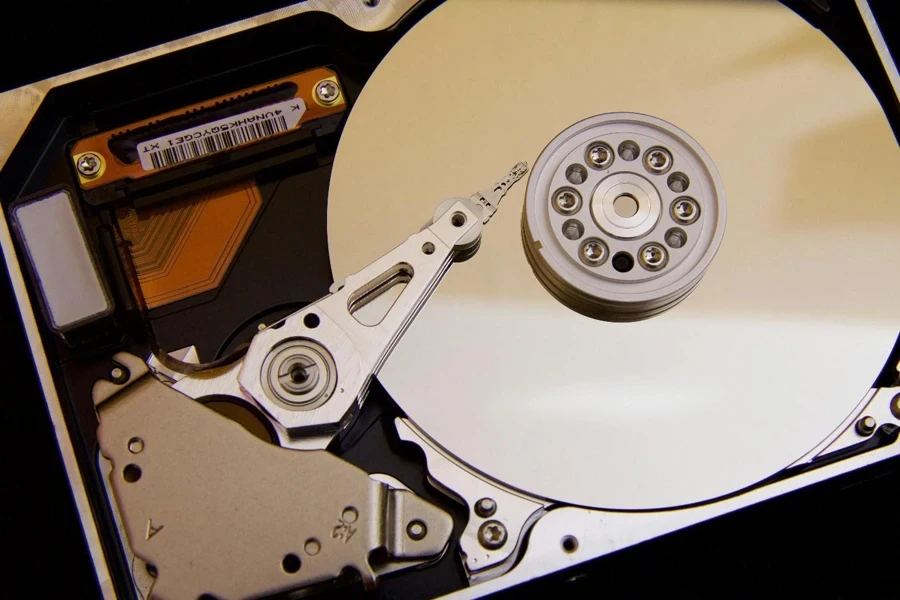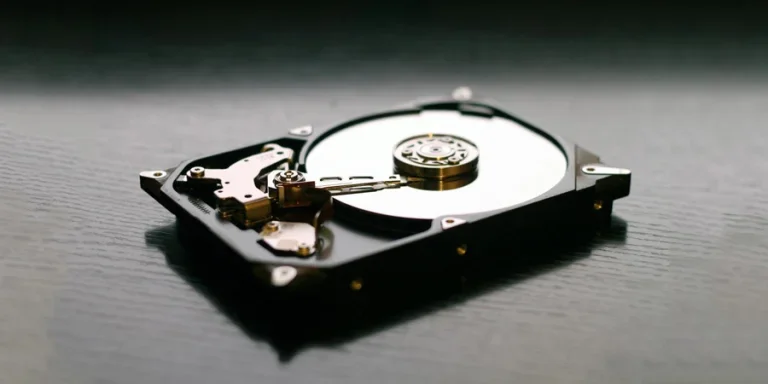Key Takeaway
- Hard disk market is projected to grow from $58.84 billion in 2023 to $100.26 billion by 2032 (CAGR 6.10%). Asia-Pacific dominates market share, driven by strong electronics and IT sectors.
- HDDs lead the market due to cost-effectiveness; SSDs are gaining traction for speed and reliability. High-capacity HDDs and portable SSDs are crucial for data centers, professionals, and rugged environments.
- Key innovations: OptiNAND, UltraSMR, Helio-seal, HAMR, MACH.2, MAS-MAMR, and NVMe HDDs.

The hard disk industry is witnessing a transformative era marked by significant advancements and emerging market trends. New technologies are enhancing storage capacities and performance, meeting the growing demand for reliable data solutions. The market is expanding at a remarkable rate, driven by innovations like OptiNAND and UltraSMR. High-capacity and rugged external drives are becoming increasingly popular among professionals and businesses. As the landscape evolves, hard drives remain a critical component in data management and storage, promising a future of continued growth and innovation.
Table of Contents
● Market overview
● Key technology and design innovations
● Top-selling models driving market trends
Market overview

Market scale and growth
The hard disk market is poised for substantial growth, driven by escalating storage demands across various sectors. In 2023, the market size was valued at USD 58.84 billion, and it is expected to reach USD 100.26 billion by 2032, growing at a compound annual growth rate (CAGR) of 6.10% from 2024 to 2032. This growth is propelled by the increasing adoption of digital storage solutions and the rising need for efficient data management systems. The market’s expansion is supported by advancements in hard disk technology, which have significantly enhanced storage capacities and performance.
Market shares are distributed across different types of hard drives and regions. HDDs currently hold the majority share, driven by their cost-effectiveness and high storage capacities. SSDs are rapidly gaining traction due to their superior speed and reliability, with hybrid drives (HHDs) also carving out a significant market presence. Regionally, Asia-Pacific leads the market, holding the largest share due to its burgeoning consumer electronics industry and robust IT infrastructure. North America and Europe follow, with substantial contributions from business and governmental sectors.
Key technology and design innovations

OptiNAND technology
OptiNAND technology integrates HDDs with embedded flash drives (EFDs) to enhance both performance and capacity. This innovation reduces the frequency of adjacent track interference (ATI) refreshes, which typically degrade performance and increase latency. It stores crucial metadata in the flash drive, allowing for faster indexing and more efficient data management. The write-cache function ensures that data in the write queue is preserved even during power loss, significantly improving reliability.
UltraSMR technology
UltraSMR technology advances shingled magnetic recording (SMR) by significantly increasing areal density and enhancing error correction capabilities. This method overlays tracks on a disk sequentially, similar to roof shingles, which maximizes the storage space. Integrating technologies like two-dimensional magnetic recording (TDMR) and soft-track error correction code (STECC), UltraSMR achieves higher capacity and data integrity. The improved error correction mechanism helps maintain data accuracy, which is critical for high-density storage applications.
Triple-stage actuator
The triple-stage actuator technology in HDDs enhances head positioning accuracy, leading to higher data density and faster read/write speeds. This technology includes three independent pivot points: the Voice Coil Motor (VCM), milli-actuator, and micro-actuator. The milli-actuator adjusts positions to 200 nanometers, while the micro-actuator refines this adjustment to 100 nanometers, ensuring precise positioning over data tracks. This high precision reduces vibrations and improves overall drive performance, making it suitable for high-capacity storage needs.

Helio-seal technology
Helio-Seal technology fills hard drives with helium instead of air, reducing internal resistance and heat generation. Helium allows for closer placement of platters, increasing the storage capacity. The technology also lowers power consumption and reduces noise and vibration, enhancing the drive’s reliability and longevity. The drives are hermetically sealed to prevent helium leakage, which adds complexity but significantly benefits data centers needing high-capacity and efficient storage solutions.
HAMR technology
Heat-Assisted Magnetic Recording (HAMR) uses a nanoscopic laser diode to heat the disk material temporarily, allowing smaller, more stable data bits to be written. This process dramatically increases storage density, achieving up to 10 terabits per square inch. HAMR drives feature glass-based platters that can withstand temperatures up to 752°F (400°C), ensuring durability and longevity. These drives are essential for future high-capacity storage solutions.
MACH.2 Multi-actuator technology
MACH.2 multi-actuator technology improves HDD read/write performance by using two independent actuators that can operate simultaneously. This design doubles the drive’s input/output operations per second (IOPS), increasing data throughput and reducing latency. Each actuator can access different parts of the drive independently, effectively handling more tasks in parallel. This technology is particularly advantageous for environments requiring high-speed data access, such as large-scale data centers.
MAS-MAMR technology
Microwave-Assisted Magnetic Recording (MAS-MAMR) increases areal density by using targeted microwave energy to manipulate the magnetic orientation of data bits. This method allows more data to be stored without sacrificing performance or reliability. The technology employs a bi-oscillation spin torque oscillator to generate concentrated microwave energy, enabling stable performance at high densities. MAS-MAMR drives can exceed 30 terabytes, catering to the growing demand for large-scale storage solutions.
NVMe HDDs
NVMe HDDs use the non-volatile memory express (NVMe) protocol, traditionally used in SSDs, to enhance HDD performance. This integration offers higher bandwidth and improved data throughput by leveraging the PCIe bus on computer motherboards. NVMe HDDs support multi-actuator technologies, leading to significant performance improvements while maintaining the same hardware. These drives provide substantial energy savings and standardization benefits, making them ideal for modern data centers focused on efficiency and performance.
Top-selling models driving market trends

High-capacity HDDs
High-capacity hard disk drives (HDDs) with storage capacities exceeding 1 terabyte (TB) are critical for managing large-scale data storage needs. These drives typically use technologies such as shingled magnetic recording (SMR) and heat-assisted magnetic recording (HAMR) to increase storage density. SMR allows for overlapping data tracks, which boosts the drive’s capacity without increasing its physical size, while HAMR uses a laser to heat the recording material, enabling more data to be written in a smaller space. These high-capacity HDDs are essential for data centers and enterprises, providing a cost-effective solution for storing massive datasets, archiving, and backup operations.
Portable SSDs
Portable solid-state drives (SSDs) are increasingly favored for their speed, durability, and convenience. These drives utilize NAND flash memory, which allows for rapid data access and transfer speeds, often exceeding 500 MB/s. Portable SSDs are also designed with advanced error correction and wear-leveling algorithms to enhance their lifespan and reliability. Their compact form factor and resistance to physical shocks make them ideal for on-the-go professionals, such as photographers and video editors, who need to quickly store and retrieve large files. Additionally, many portable SSDs feature hardware encryption to ensure data security during transit.
Rugged external drives
Rugged external drives are engineered to endure harsh environments, featuring robust casings that protect against drops, vibrations, and water ingress. These drives often comply with military standards for durability, such as MIL-STD-810G, which involves rigorous testing for shock and environmental conditions. Internally, they may use SSD technology to eliminate the vulnerabilities associated with moving parts in traditional HDDs. Some rugged drives also incorporate advanced sealing techniques and materials like silicon to provide IP67 or IP68 ratings, ensuring they are dustproof and waterproof. These features make rugged external drives indispensable for fieldwork, outdoor activities, and industrial applications.
Desktop storage solutions
Desktop storage solutions, including both high-capacity HDDs and SSDs, are essential for users requiring extensive and fast storage. Desktop HDDs commonly offer capacities up to 18 TB, utilizing technologies like perpendicular magnetic recording (PMR) and helium-filled drives to enhance performance and reliability. These drives are ideal for media professionals who need to store large video files, music libraries, and graphic design projects. Desktop SSDs, on the other hand, leverage NVMe (Non-Volatile Memory Express) interfaces to deliver exceptional read/write speeds, often exceeding 3,000 MB/s. This speed is crucial for gamers and professionals who need quick access to large files and applications, reducing load times and improving overall system responsiveness.
Innovative storage solutions
Innovative storage solutions such as hybrid drives and advanced NVMe protocols are pushing the boundaries of data storage technology. Hybrid drives combine the high storage capacity of HDDs with the speed of SSDs by integrating a small amount of NAND flash memory with traditional spinning disks. This hybrid approach provides faster data access for frequently used files while maintaining the large storage capacity of an HDD. Advanced NVMe protocols enable SSDs to connect directly to the CPU via the PCIe interface, bypassing the slower SATA interface used by traditional drives. This direct connection significantly reduces latency and increases data transfer rates, making NVMe SSDs ideal for high-performance computing environments and applications requiring rapid data access.
Conclusion
The hard disk market is experiencing significant growth and transformation, driven by technological advancements and changing consumer demands. Innovations such as OptiNAND, UltraSMR, and HAMR are enhancing storage capacities and performance, while the increasing adoption of high-capacity HDDs and portable SSDs is meeting the diverse needs of various industries. As these technologies continue to evolve, the future of data storage promises even greater capacities and faster, more reliable performance, ensuring that the market remains dynamic and robust.





 Afrikaans
Afrikaans አማርኛ
አማርኛ العربية
العربية বাংলা
বাংলা Nederlands
Nederlands English
English Français
Français Deutsch
Deutsch हिन्दी
हिन्दी Bahasa Indonesia
Bahasa Indonesia Italiano
Italiano 日本語
日本語 한국어
한국어 Bahasa Melayu
Bahasa Melayu മലയാളം
മലയാളം پښتو
پښتو فارسی
فارسی Polski
Polski Português
Português Русский
Русский Español
Español Kiswahili
Kiswahili ไทย
ไทย Türkçe
Türkçe اردو
اردو Tiếng Việt
Tiếng Việt isiXhosa
isiXhosa Zulu
Zulu